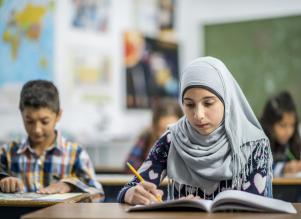1/21/2019
Adolescent Literacy: Addressing the Needs of Refugee Students
Students who come to the classroom as refugees often bring with them a host of unique opportunities and challenges. First, a little clarity: Refugees end up in the United States after fleeing unsafe situations in their home countries. Immigrants, in contrast, are people who have purposefully chosen to come to this country and typically do so with the help of visas or family members who are already settled here. Many refugees have experienced high levels of trauma, stress, and disruption, and may spend years in a refugee camp before being resettled in countries such as the United States. Because of this, young people with refugee status have frequently had little to no access to a formal education.
The lack of educational opportunities for refugee children is an international crisis in the eyes of many global aid groups—including Human Rights Watch, which produced a 2016 report addressing the issue. In a report called The Education Deficit, Human Rights Watch researchers detailed the severity of the problem, noting that millions of children around the globe do not attend school even though international law mandates that refugees under the age of 18 must be given access to an education. In fact, a 2017 article published by the National Education Association (NEA) noted that, according to a United Nations report, just 22 percent of adolescent refugee students around the world—mostly those living in urban areas—are able to go to school.
These sobering statistics indicate that by the time refugee students get resettled in the United States, they have often missed years of schooling and will likely be behind their peers. But this is usually just the tip of the iceberg. An article on the All About Adolescent Literacy website written by Kristina Robertson and Lydia Breiseth offers a comprehensive look at all that refugee students may be wrestling with, including mental health concerns, missing documentation, and lack of access to safe and stable housing. The authors noted that understanding the complex lives of refugee students is of special concern for English language and literacy teachers who often provide a key base of support for those who are new to English and to formal classroom settings. In addition to acknowledging the clear challenges that may go along with this work, the writers pointed out that English language educators have a “unique opportunity to help educate our mainstream students and families about newly arriving refugees, develop cultural understanding and acceptance, and smooth the transition for both refugees and mainstream students.”
One central takeaway from Robertson and Breiseth is that “students with interrupted formal education are not less intelligent than other students their age” and do not necessarily require special education services. Instead, they may be in what high school teacher Michelle Lawrence Biggar has termed either a “pre-production” or “silent” stage. In a short video designed to address this topic, Lawrence Biggar advised teachers to allow SIFE (students with interrupted formal education) to “express themselves non-verbally” and to engage in labeling items—all while being exposed to age-appropriate content. She acknowledged that although students will often be able to understand the content, they may be only able to “produce key words.” This taps into a point made by Robertson and Breiseth about refugee students: “They are capable of learning English and the skills necessary to be successful academically; it will just take longer than mainstream students and even other ELL students who have had formal education in their own language in their home country.”
An important way to reach refugee students is to empower them, according to a 2016 article in Middle Grades Review. “Understanding the Needs of Adolescent Refugee Students,” written by Bobette Bouton of Austin Peay State University in Tennessee, seeks to provide a “framework for readers to understand the kaleidoscope of issues that face our refugee adolescent population.” Bouton shared research-based insight into the needs of refugee students and noted that these individuals should be encouraged to not only find community with one another but to “talk and write about their experiences.” Teachers can build effective relationships with refugee students by prompting them to address their often traumatic pasts, even though they may feel pressed for time or unsure of how to handle their students’ painful stories. Ultimately, helping students feel listened to and understood can help motivate them to attend school regularly and find value in their coursework.
Websites such as All About Adolescent Literacy and Colorin Colorado offer teacher resources and ideas for how to positively and productively address the range of needs and experiences that refugee students bring to class. According to the former, step one is to create a “welcome process” for new refugee students and families. This asks teachers and school staff to become well acquainted with the customs and cultural practices of the refugees’ home countries as a way to foster trust and mutual respect. Another idea is to create a buddy system wherein “trained peers” act as ambassadors and guides for new students—indeed, knowing, being able to empathize with, and advocating for students is often listed as a crucial way to set students with refugee status on the path towards academic success.
In terms of adolescent literacy, addressing the needs of refugee students is a high-stakes endeavor. As Dr. Mary Mendenhall of the Teachers College, Columbia University argued, without access to an education, “We risk losing yet another generation of children to illiteracy, ignorance, poverty, and the need to turn toward desperate and extreme solutions to meet their basic needs.”
WHAT DO YOU THINK?
Connect with us on Twitter, Facebook, and LinkedIn and let us know your thoughts and experiences on this important topic.


